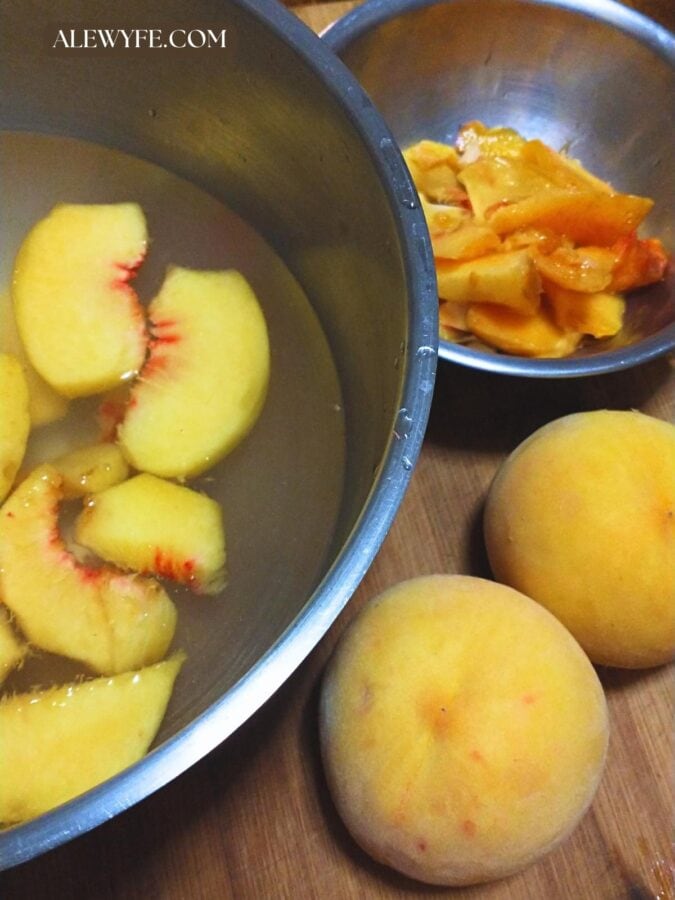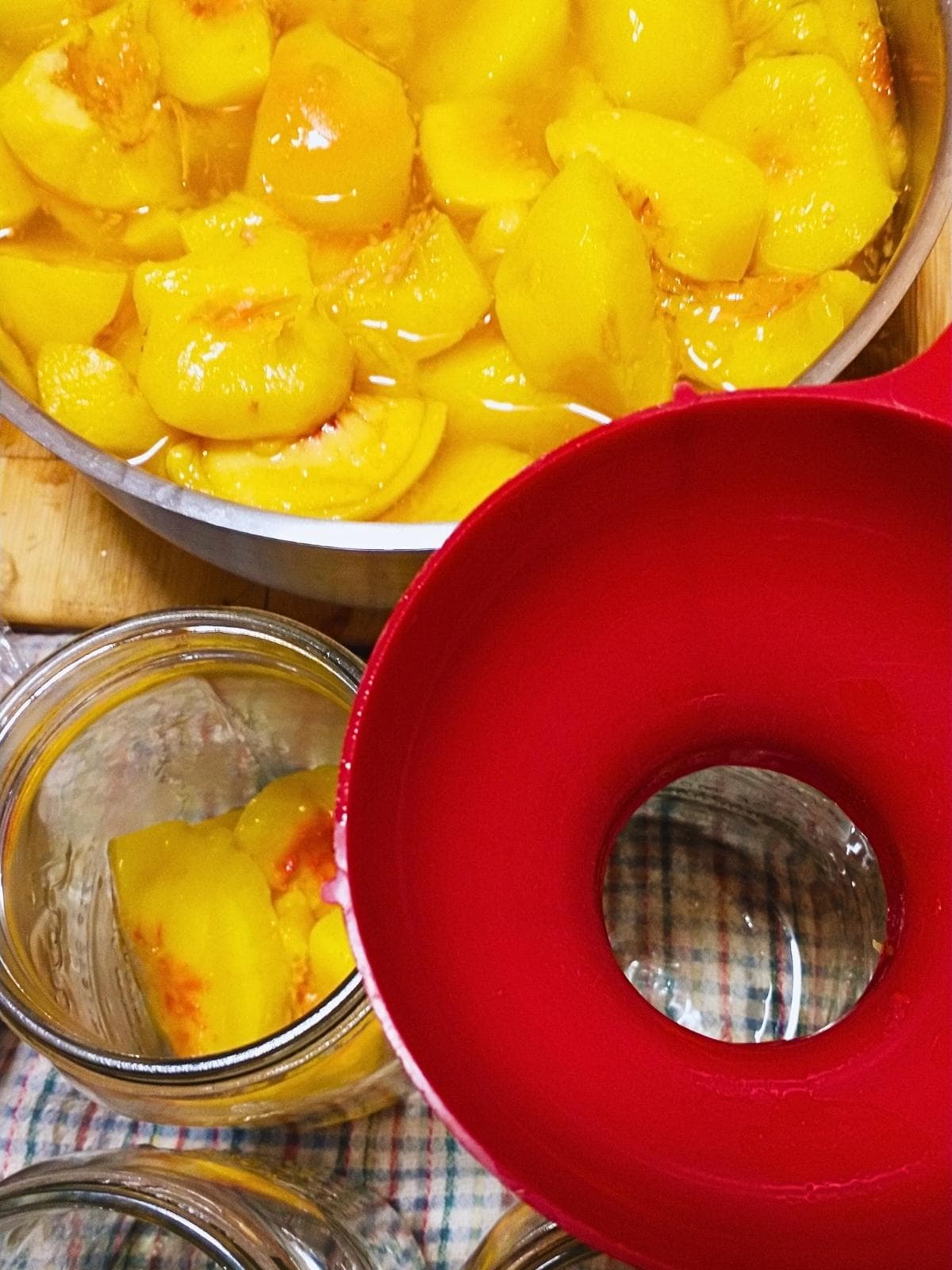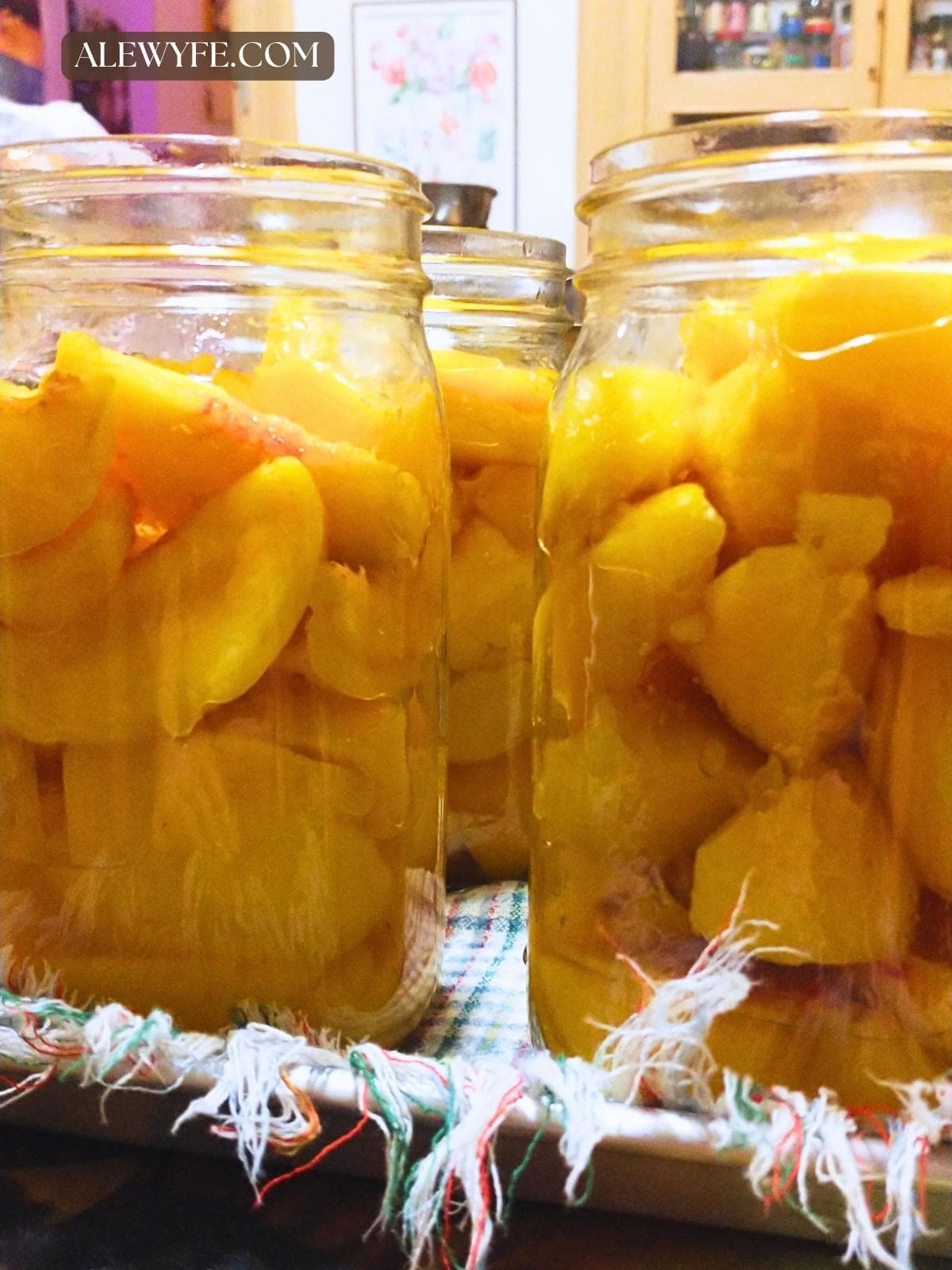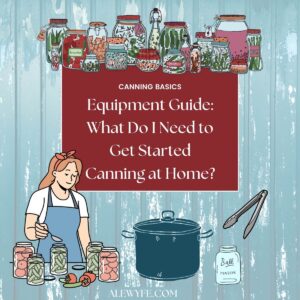CANNING: Cinnamon or Spiced Summer Peaches (Easy Raw-Pack Water-Bath Recipe)
- What is the difference between raw and hot packing methods?
- What equipment will I need?
- Important note about peach varieties
- Do you need to peel the peaches?
- Step-by-Step Guide to Canning Fresh Peaches
- Light Cinnamon or Spiced Syrup & Variations
- Spiced Syrup Infusion Suggestions

Do you want to can peaches to preserve the fresh taste of summer to enjoy year-round, but aren’t sure where to start? Is it blazing-hot in your kitchen and you just want something simple and easy, and you don’t have room in your freezer to put one more thing in there?
These simple spiced peach slices or halves in a light cinnamon syrup are a great entry-level canning recipe or simple standby for any home canner who is pressed for time (and really, isn’t that most of us these days?).
It’s a raw-pack water-bath canning recipe, which means you need very little specialized equipment to safely preserve canned peaches at home!
What is the difference between raw and hot packing methods?
Raw Pack:
- Fruits or vegetables are washed, peeled, sliced, cored, or otherwise prepped, and packed in a hot, clean canning jar. They are topped up with simple syrup or brine and processed in a canner.
Hot Pack:
- Fruits or vegetables are washed, peeled, sliced, cored, or otherwise prepped, and submerged in simmering simple syrup, hot brine, or salted water. They are then quickly packed in a hot, clean canning jar. They are topped up with simple syrup or brine and processed in a canner.
Done correctly (and with the right processing for the food type- either water-bath, steam, or pressure-canning for high-acid foods, pressure-canning only for low-acid foods), both methods are safe.
Raw Pack foods are processed slightly longer in the water-bath, but it’s hands off time and the extra processing time is usually a lot less than the extra handling time it takes to blanch and hot-pack foods.
So why do some people bother with hot packing?
It can yield a better quality product or more fruit or vegetables per jar, as the extra step of blanching releases air trapped in the fruit before processing. Fruit and vegetables that have a lot of trapped air can float in the jar even after processing, leading to discoloration of anything above the liquid level in the jar. This isn’t unsafe, but it can be unsightly and cause a loss in quality or flavor.
Thankfully, it isn’t always an issue, and soft fruits like peaches can often be raw-packed without a loss in quality (and a big savings in time for you). Save the hot packing for your apple slices and let’s jump right in there and put up these peaches (they might not wait another day!).
It’s always better to can them NOW as a raw-pack rather than letting them spoil while you wait to get the motivation or time to do a hot pack!
What equipment will I need?
You’ll want a large stainless or enameled stockpot or two, another large pot or boiling water bath canner, as well as clean canning jars and new lids. It’s also best to have jar tongs or a rack, regular tongs, a slotted spoon & large ladle, and other basic canning tools.
If you’re new to canning, we have a full guide to what you might want to have on hand and what tools you will definitely need!
Important note about peach varieties
Most yellow peaches are a high-acid fruit, and can be safely canned in a water bath (no pressure canner needed).
Note- you cannot safely water-bath can white-fleshed or donut peaches, as they’re much lower in acid than yellow-fleshed varieties. If you need to preserve those, I recommend drying or freezing them!
You can use either free-stone or cling-stone yellow peaches for this recipe. Free-stone are easier to process, and are just what they sound like- the pits are less firmly attached to the fruit and come out easier.
If you are doing slices, you can use either free or cling-stone, but for canning peach halves it’s worth it to find free-stone peaches if you can.
If you’re buying from a local orchard (or planning what to plant for your own backyard fruit trees) ask which varieties they are to save yourself some hassle (or if you need to can halves for your recipes).
Do you need to peel the peaches?
Yep! You need to remove the peels both for texture and food safety reasons. This is where the bulk of yeast, mold, or other spoilage organisms are, so peeling adds (or rather, removes?) a layer of safety and prevents spoilage.
But mostly, it’s a quality issue. The skin will have a tough unpleasant texture and mouthfeel after canning, so you definitely want to remove it.
What can I do with the peach peels?
You can save the peels & pits to make peach vinegar. If you have chickens or a compost bin, either will make use of the peels (but if you compost the pits, you may end up with volunteer seedling trees of unknown quality). You can also simmer them to extract more of the peach flavor and use it to make peach nectar.
To do this, simmer them with any irregular fruit trimmings leftover from canning the slices and your leftover canning syrup (add sugar or honey and water to taste if you don’t have leftover syrup). Puree, strain, and then can the fruit nectar. I’ll make a separate post about this at some point… I love to add this to iced tea, mixed drinks, and popsicles as well as just enjoying it chilled as a refreshing drink.
Step-by-Step Guide to Canning Fresh Peaches
- Gather Materials & Equipment (canning pot, jars, smaller pots for syrup and blanching, canning tools like jar funnels and tongs, clean towels and spoons)
- Simmer the Cinnamon or Spiced Syrup (to infuse while you prepare the fruit for the jars)
- Wash the Fruit
- Trim off any Damaged Areas
- Blanch and Peel the Fruit (blanch again if the peels are stubborn)
- Slice or Halve the Peaches and Remove the Pits
- For Hot Pack, Blanch the Peaches in Syrup and then Pack into Hot Jars
- For Raw Pack, Pack the Peaches into Hot Jars
- Top up with Hot Syrup or Boiling Water
- Wipe Jar Rims and Secure New Canning Lids
- Transfer Jars into Boiling Water-Bath
- Process for allotted amount of time (check processing time for your method- this varies with jar size, altitude, and raw vs hot pack)
- Remove from Canner and Cool
- Check Seals, and Stash your Precious Peaches in your Pantry!

Light Cinnamon or Spiced Syrup & Variations
The “light” in this syrup doesn’t mean it’s diet or sugar-free. It just has a lower sugar level and is less thick than a “heavy” syrup. You can safely can your peaches in plain water or even fruit juice (apple or white grape juice), but the sugar in this syrup will help keep the fruit brightly colored and firm in storage.
If it’s a dietary concern, you can reduce or even omit the sugar in this recipe, or replace it with honey or “raw” sugar if you prefer the flavor. I prefer to keep these fairly neutral for versatility, and like using white sugar here.
The syrup is simmered briefly to dissolve the sugar, and to infuse it with a cinnamon stick. This will lightly flavor the syrup and add a depth of flavor without being overpoweringly cinnamon flavored.
Spiced Syrup Infusion Suggestions
I recommend using whole spices when possible. You can also use powdered spices but these will make the syrup cloudy.
Feel free to experiment with your favorite whole spices, but remember, less is more! I have kept this canning syrup very simple and lightly flavored so the peaches can be used in any recipe. Some suggestions to add with or instead of the cinnamon stick if you want a more highly spiced syrup:
- a tablespoon of coriander seeds
- a couple whole cloves
- a cardamom pod (green or black)
- sliced fresh or candied ginger
- a few allspice berries (whole or cracked)
- a small piece of a whole nutmeg
- Or make a vanilla syrup with cinnamon stick and a split vanilla bean!
If you are canning a lot of peaches (like if you have several trees with a bumper crop, or bought a bushel or two of peaches from your farmer’s market, local orchard, or grocer) try putting them up in different ways.
I would do a batch with the plain cinnamon syrup and then a second canner load with a more richly flavored infused syrup (make sure you keep them separate and label the jars), and save some for peach salsa, jams, compotes, and even BBQ sauce.
But if you are doing just one batch, keep it simple with a basic neutral or lightly flavored simple syrup so you don’t limit your baking options later. Now, let’s get to it, shall we?


Spiced Summer Peaches
Equipment
- 1 large stockpot or canning pot
- canning jars (wide-mouth jars are best, especially if you are doing halves, but either will work)
- new canning jar lids (or reusable Tattler lids, or Weck lids, rings, and clips)
- canning funnel (optional but helpful)
- jar tongs or rack with handles
- false bottom for canner or silicone trivet to protect bottoms of jars from scorching
Ingredients
Peach Slices or Halves
- yellow peaches, ripe freestone are easier to process but clingstone is fine. White peaches are NOT fine, only yellow can be safely water-bath canned.
- 2 quarts cold water or to cover
- 2 tbsp lemon juice or ½ tsp ascorbic acid powder (vitamin C) (both optional but improves quality and prevents browning)
Light Cinnamon Syrup
- 7 cups water
- 3 cups white sugar
- 1 large cinnamon stick
- 1 tbsp lemon juice
Spiced Cinnamon Syrup Variation:
- 7 cups water
- 3 cups white sugar
- 1 large cinnamon stick
- 1 tbsp coriander seeds
- 2-3 whole cloves
- 1 piece cardamom 2-3 pods of green or ½ pod black
- 2-3 berries whole allspice (or cracked)
- 1 slice candied ginger (or fresh)
- 1 tbsp lemon juice
Instructions
Light Cinnamon or Spiced Syrup:
- For the spiced syrup, either place loose spices in a metal tea infuser or bundle of cheesecloth tied with cooking twine, or strain the finished syrup with a mesh strainer before using. The cinnamon stick is easy to remove with a slotted spoon, so it can be placed loose in the syrup to more freely infuse in either version.
- Combine sugar, water, and spices in a large pot and bring to a simmer. Simmer at least 10 minutes and then keep hot while you prep the peaches. You can leave the spices in until you are ready to pack the jars if you want a stronger infusion, or remove them once you have the flavor you want.
Prep Peach Slices or Halves
- Fill the canner with water and add the jars to sterilize as you bring it up to a boil (not strictly necessary, especially if you are using new or otherwise spotlessly clean jars, but it's never a bad idea). Do not boil the lids, just the empty jars. Cover the canner to trap heat so it boils faster and loses less steam into your kitchen.
- Wash the peaches and trim any bad bits generously. Do not use moldy fruit but damaged peaches are ok- trim them well to remove bruised areas.
- To peel the peaches, blanch the peaches a few at a time in a pot of simmering water. Leave them in the water for 30-60 seconds, then rinse under cold running water or dunk in a bowl of ice water to stop the cooking.
- The peels should easily slip off. If they don't, return to the simmering water and blanch again. You can save the peels to make peach vinegar or peach nectar (see notes in a future post... for now either freeze or compost them).
- In a large mixing bowl, combine the cold water and either lemon juice or ascorbic acid (vitamin C or "Fruit-Fresh" in the canning aisle). As you slice the peaches, place them into the acidulated water, which will keep them from oxidizing and browning and preserve their bright, fresh color.
- Slice or halve the peaches into your lemon water and remove the pits. Either discard the pits or save and set aside to roast and make peach creme de noyaux liqueur (another future post). Save any ugly or irregular but not spoiled bits of peaches in another bowl if you want to make peach nectar or puree (you can can these with your nice slices too, it's just an aesthetic decision).
Pack Peaches in Canning Jars
- When all the peaches are blanched and sliced and dunked, start packing your jars. I like to use wide-mouthed jars, especially if I am doing halves or large slices, but regular mouth jars work too (and the jar shoulders help keep the canned fruit submerged under the syrup... they're just more tricky to pack). Use what you have or prefer! A jar funnel will be helpful here and keep the rim of your jars cleaner.
- Ladle hot syrup over the peach slices, leaving ½" headspace at the top of the jar. Using a chopstick, debubbling tool, butterknife, or thin spatula, gently poke around in the jars to dislodge any trapped air bubbles to make sure the peaches are fully submerged in the hot syrup. They will float to the top- this is ok- just make sure there aren't any pockets of trapped air around the fruit.
- Wipe the rims of the jar with a clean cloth or paper towel dipped in hot water (or hot water and white vinegar, which I prefer). Make sure the rims of the jars are clean, then top with new, clean canning lids and rings. Tighten them finger-tight (gently snug but not overtightened... this may take some practice but unless you are using reusable lids, not hard to figure out. Reusable lids have a learning curve and are best for more experienced canners).
Process Jars in Boiling Water Bath
- Place the jars in your boiling water bath canner and make sure they are covered with at least an inch of boiling water over the tops of the jars. Place the lid on the canner and listen until it is vigorously boiling again. Once the pot is boiling, start your processing timer.
- Process raw-pack pints and quarts for 30 minutes (IMPORTANT: this is for elevations at or below 1000 ft... see notes for processing time adjustments for higher elevations or hot pack). After the processing timer goes off, turn off the heat and set a timer for 5 minutes.
- After 5 minutes, using jar tongs or a canning rack remove the jars from the canner and place on a folded kitchen towel or metal grid cooling rack. Do not place hot jars on a cold counter (especially stone, concrete, or metal) or they may crack and break from thermal shock! I always use a sheet pan lined with a folded kitchen towel just to be safe.
- Leave jars undisturbed to cool completely before checking for seals... I usually leave them overnight and check them in the morning. Wait at least 6-8 hours and no more than 24 before checking them, so that you can safely reprocess or refrigerate any jars that didn't seal. If you reprocess, use a new lid and don't put cold jars into a hot canner.
- Wash the jars (they may be sticky, as some juice escapes during processing- this is normal and fine) before labeling and storing them in a cool, dark pantry or cupboard. Home canned peaches are best in the first year but are safe to eat as long as the seal is intact and the jars haven't frozen. They will discolor over time and lose taste and quality, especially if they are exposed to light, heat, or large temperature variations.
Notes
Processing Times for Higher Elevations and Hot Pack Peach Slices or Halves
Ball Blue Book times are listed as 30 minutes for pints or quarts. The following data is from the NCHFP. Raw Pack: Pints: (0-1000 ft): 25 minutes (1001-3000 ft): 30 minutes (3001-6000 ft): 35 minutes (above 6000 ft): 40 minutes Quarts: (0-1000 ft): 30 minutes (1001-3000 ft): 35 minutes (3001-6000 ft): 40 minutes (above 6000 ft): 45 minutes Hot Pack: Pints: (0-1000 ft): 20 minutes (1001-3000 ft): 25 minutes (3001-6000 ft): 30 minutes (above 6000 ft): 35 minutes Quarts: (0-1000 ft): 25 minutes (1001-3000 ft): 30 minutes (3001-6000 ft): 30 minutes (above 6000 ft): 35 minutesRelated Recipes:
-
Pear Halves in Vanilla or Cinnamon Syrup (water bath canning recipe)
-
Millions of Peaches, Peaches for Free (and a Spicy Peach BBQ Sauce Canning Recipe)
-
Whiskey Peach Brown Sugar Compote (water bath canning recipe)
-
Canning Strawberry Lemonade Concentrate
-
How to Can White Grape Juice and Cranberry-Grape Juice (no juicer needed!)
-
Southern Fried Cornmeal-Crusted Catfish Salad with Peaches & Pecans


Hi Carla, just followed your recipe and love it, am wondering about the recipe to make peach nectar from the skins. Sure would appreciate it
Hi Dawn, thanks, and I’m glad that it helped! Unfortunately we had a late frost this spring, so no new peach canning recipes this year from me, boo. But some tips that should get you there: Bernardin/Ball has a tested peach nectar recipe online (I tried to link it here but you’ll have to search). It’s written for peeled and pitted peaches… I usually simmer the skins in enough water to cover, puree them in a blender, run through a mesh strainer, then combine with some fresh peaches (usually the trimmings and ugly pieces that were too small to can as halves or leftover slices after I fill a batch of jars) and water (at least one cup of water per quart of fruit- I use the strained peach peel water for this). You do need fruit along with the peels to make sure it’s acidic enough to can (I also add acid to the jars before processing). Simmer that all together, sweeten to taste with simple syrup or honey (or apple juice), bring to a simmer for a few minutes, then hot pack. I add two tablespoons of lemon juice or at least a half teaspoon of citric acid per quart (for flavor, pH adjustment, and to help protect the color). Water bath process for 15 minutes.
Or, if you don’t have more fruit, simmer, puree, and strain the peach peels with water, then use this to make a simple syrup for iced tea. Store that in the fridge or freeze it in ice cube trays to pop into a batch of iced tea for lightly peachy sweet tea!
Does not say how many peaches are used for this recipe.
Hi Kelly, there are estimated weights noted in the recipe description for peaches needed to fill standard jars, and an estimated yield for the syrup volume in the recipe. Because peaches are a natural product & vary in size, how many you will need to fill your jars will vary, but weights are a good way to estimate how many peaches you will need to get the number of jars you want! (From the recipe description: “Each quart jar takes about 2½ lbs of fresh peaches, or 1¼ lbs per pint jar. The syrup recipe should be enough for a full 7 quart canner load, or a smaller batch of slices and then a batch of peach nectar.”) Happy canning! :)